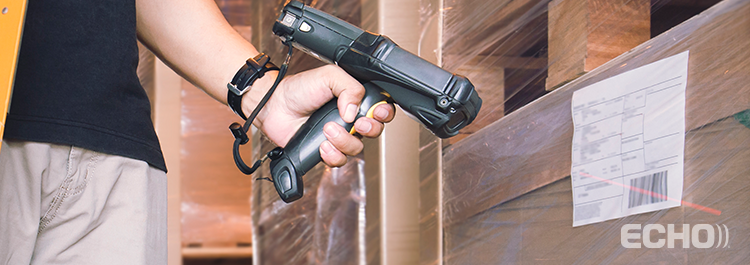Common questions we often hear at Echo Global Logistics when assisting clients with less than truckload (LTL) shipments revolve around evaluating freight class and avoiding reclassification charges and fees. If you’re new to shipping LTL, the class system can be difficult to navigate.
Why Does LTL Use Freight Classes?
The National Motor Freight Traffic Association (NMFTA) created an industry-wide standard for logistics professionals known as National Motor Freight Classifications, or NMFC codes, to help simplify the process of comparing different commodities and calculating LTL costs. This numeric-based system groups commodities into one of 18 different freight classes spanning from a low of class 50 to a high of class 500 based on four essential transportation characteristics:
- Density: Density is identified by the space an item occupies in direct connection with its weight. It’s calculated by dividing the weight of the item in pounds by its volume in cubic feet. Density guidelines assign class 50 to freight that is more than 50 pounds per cubic foot (PCF). Freight with a density of less than 1 PCF is assigned class 500. The denser your freight is, the less it will cost you per pound to ship.
- Liability: Liability has to do with how likely your freight is to be damaged or targeted for theft. Freight that is perishable or combustible is likely to be assigned a higher freight class. Commodities that are considered highly valuable, such as copper or electronics, also receive a higher freight class.
- Stowability: If your freight is difficult to stow with other items in a shipment, this can raise the freight classification. Additionally, items that are under government regulation or are subject to certain carrier policies may not be able to ship with other items. Basically, anything that limits freight storage options results in a higher freight class.
- Handling: If loading or unloading your freight requires special equipment due to its weight, shape, fragility, or hazardous material contents, it could be assigned a higher freight class.
These characteristics ultimately work to identify how difficult it is to transport an item. As you can see, products that are harder to ship are assigned higher classes. In other words, the higher the class, the higher the freight rates per pound.
Regardless of the initial price, a shipper’s ability to correctly label a shipment’s class code and number on a bill of lading can mean the difference between a hassle-free shipping experience and an unexpected carrier reclassification fee. Carriers are paid for the services they provide, so they might reclass your shipment, charge you for the incremental rate, and add a fee for all the trouble.
Related Material: How to Prepare for Accessorial Charges on LTL Shipments
Changes to NMFC Codes
A few times each year, the NMFTA publishes changes to their existing classification catalog. Partnering with a 3PL such as Echo can help you stay in front of those changes and be prepared.
As an example, below are some changes to NMFC items from April, 2021 as well as some proposed changes to take effect in December, 2021. Allow Echo to work as your partner and alert you to upcoming changes.
On April 10, 2021, the NMFTA effected Supplement 1 to NMF 100-AU. Here’s a quick snapshot of how shippers were impacted:
- Several Foodstuffs items are being canceled and replaced with new NMFC 73260, which is an 11-tiered density item, including:
- 72040-Bakery goods other than frozen
- 72042-Bars
- 72270-Brownies, other than frozen
- 72680-Coffee, tea, or herbal tea
- 73227-Breads, rolls, and cake
- 73270-Fortune cookies
- 74800-Snack foods
- Stairs or Stairways; Ramps or Gangways; Chutes or Slides; Platforms or Stands: NMFC 178160, currently 2 classes (SU class 300) and KD (class 125) will be changed to 8 classes based on dimension and density
- Glass, flat, bent or, not bent NOI items: NMFC 86700, currently 6 classes based on dimension and density will be expanding to 14 classes based on dimension and density
- Glass, silvered for mirrors items: NMFC 86900 will be canceled and replaced with NMFC 86700
- Sneeze Guards or Food Shields: NMFC 82285, currently 2 classes (150 and 175) based on dimensions will be expanding to 8 classes based on dimensions and density
- Chemicals Group: NMFC 42600 will be revised into three class tiers based upon Packing Groups I, II, or III. Statements also added identifying items that are not required to bear a Hazard Class or Hazard Division label. Please download full document below for more information.
- Poisonous or Toxic Materials: NMFC 45615. Subs/Classes no longer based on Hazard Zone. Classes now based on whether poisonous by inhalation or not poisonous by inhalation, or by packing group number
Effective December 4, 2021, the Freight Classification Development Council (FCDC) of the NMFTA approved changes to the NMF 100-Tariff. Here’s an overview of how shippers will be impacted:
- Subject 1 – Foodstuffs, Item 73227 canceled and replaced by 72310, 73260 and 73365
- Subject 5 – Faucets
- Subject 7 – Boxes, Chests or Cabinets, Tool, Ammunition or Fishing Tackle
- Subject 14 – Charcoal, Charcoal Briquettes or Charcoal Pellets
- Subject 15 – Broilers, Grills, Roasters or Stoves, cooking, outdoor type, electric
- Subject 21 – Wood Chips or Wood Chunks
- Subject 25 – 122000 Grading or Road Making Attachments or Implements, or Parts thereof
To see a full list of updated density/class progression and NMFC items impacted, click here.
What You Can Do
If you are unsure or need help interpreting a product’s NMFC code, there are lot of options.
- Work with a Trusted Third-Party Logistics Provider (3PL)
- The experts at Echo are ready to guide you through the Freight Class process
- Our team will help evaluate your transportation and freight class needs, discover efficiencies, and deliver the transportation solutions that are best for your business
- The manufacturer of your product will most likely know the NMFC code of an item, so you can reach out to them directly as well
Related Material: How to Notate Damages and Shortages on the Bill of Lading and Proof of Delivery
Contact an Echo representative today at 800-354-7993 or info@echo.com, or request a quote for a shipment.
Informational



